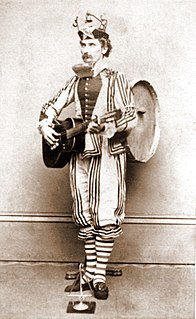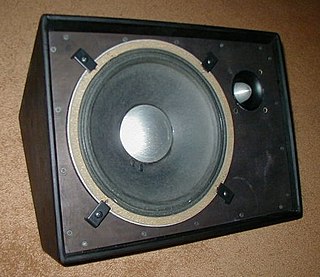
A drum kit – also called a drum set, trap set or simply drums – is a collection of drums, cymbals and other percussion instruments, which are set up on stands to be played by a single player, with drumsticks held in both hands and the feet operating pedals that control the hi-hat cymbal and the beater for the bass drum. A drum kit consists of a mix of drums and idiophones – most significantly cymbals, but can also include the woodblock and cowbell. In the 2000s, some kits also include electronic instruments. Also, both hybrid and entirely electronic kits are used.
Roland Octapad is a range of MIDI electronic drum percussion controllers produced by the Roland Corporation.

A drum machine is an electronic musical instrument that creates percussion sounds, drum beats, and patterns. Drum machines may imitate drum kits or other percussion instruments, or produce unique sounds, such as synthesized electronic tones. Most modern drum machines allow users to program their own rhythms and beats. Drum machines may create sounds using analog synthesis or play prerecorded samples. Some drum machines have buttons or pads that allow the performer to play drum sounds "live", either on top of a programmed drum beat or as a standalone performance. Drum machines have a range of capabilities, which go from playing a short beat pattern in a loop, to being able to program or record complex song arrangements with changes of meter and style.

GarageBand is a line of digital audio workstations for macOS, iPadOS, and iOS devices that allows users to create music or podcasts. GarageBand is developed and sold by Apple for macOS, and is part of the iLife software suite, along with iMovie and iDVD. Its music and podcast creation system enables users to create multiple tracks with pre-made MIDI keyboards, pre-made loops, an array of various instrumental effects, and voice recordings.

A rhythm section is a group of musicians within a music ensemble or band that provides the underlying rhythm, harmony and pulse of the accompaniment, providing a rhythmic and harmonic reference and "beat" for the rest of the band. The rhythm section is often contrasted with the roles of other musicians in the band, such as the lead guitarist or lead vocals whose primary job is to carry the melody.

A MIDI controller is any hardware or software that generates and transmits Musical Instrument Digital Interface (MIDI) data to MIDI-enabled devices, typically to trigger sounds and control parameters of an electronic music performance.

An electronic drum is a modern electronic musical instrument, primarily designed to serve as an alternative to an acoustic drum kit or other percussion instruments. An electronic drum consists of an electronic or digital sound module which produces the synthesized or sampled percussion sounds and one or more electric sensors or sensor-equipped pads to trigger the sounds. Like regular drums, the sensors or pads are struck by drum sticks or by the hands and they are played in a similar manner to an acoustic drum kit.

A sound module is an electronic musical instrument without a human-playable interface such as a piano-style musical keyboard. Sound modules have to be operated using an externally connected device, which is often a MIDI controller, of which the most common type is the musical keyboard. Controllers are devices that provide the human-playable interface and which may or may not produce sounds of their own. Another common way of controlling a sound module is through a sequencer, which is computer hardware or software designed to record and playback control information for sound-generating hardware. Connections between sound modules, controllers, and sequencers are generally made with MIDI, which is a standardized protocol designed for this purpose, which includes special ports (jacks) and cables.

A one-man band is a musician who plays a number of instruments simultaneously using their hands, feet, limbs, and various mechanical or electronic contraptions. One-man bands also often sing while they perform.

V-Drums is a variety of electronic drums, drum brain modules, and related electronic percussion product manufactured and trademarked by Roland Corporation.

A Zendrum is a hand-crafted MIDI controller that is used as a percussion instrument. The Zendrum was influenced by the "Drumitar," invented by Future Man. There are several Zendrum models that are well-suited for live performances: the Z1, ZX, EXP, ZAP series, LT and the Mallet Pro series and Melodic Finger. The Zendrum ZX and Z1 can be worn like a guitar and consists of a triangular hardwood body with 24 touch-sensitive round MIDI triggers. The EXP has 29 triggers and additional controls. The Zendrum LT can also be worn with a guitar strap, and has 25 MIDI triggers in a symmetrical layout, which provides an ambidextrous playing surface. The ZAP series is designed more for table top use or on a drum stand, with the ZAP1 having 19 triggers, and the ZAP2 having 25 triggers. The triggers are played by tapping or slapping with the fingers or hands. As a controller, the Zendrum does not make any sound by itself. It uses an electronic interface called MIDI to control synthesizers, samplers, drum machines, sound modules, computers or other electronic drum devices that generates the musical and percussive sounds. The Mallet Pro Series is laid out and played like a traditional mallet instrument, like a marimba. The Mallet Pro series has naturally resonating solid walnut bars as triggers.
The MalletKAT is in a class of MIDI percussion controllers which also includes the DrumKAT, DK10, and TrapKAT.

Simmons is an electronic drum brand, which originally was a pioneering British manufacturer of electronic drums. Founded in 1978 by Dave Simmons, it supplied electronic kits from 1980 to 1994. The drums' distinctive, electronic sound can be found on countless albums from the 1980s. The company closed in 1999 and the Simmons name is currently owned by Guitar Center.

Live sound mixing is the blending of multiple sound sources by an audio engineer using a mixing console or software. Sounds that are mixed include those from instruments and voices which are picked up by microphones and pre-recorded material, such as songs on CD or a digital audio player. Individual sources are typically equalised to adjust the bass and treble response and routed to effect processors to ultimately be amplified and reproduced via a loudspeaker system. The live sound engineer listens and balances the various audio sources in a way that best suits the needs of the event.

An electronic drum module is an electronic or digital music device in an electronic drum kit that serves as the central processing unit and sound module. The drum module creates or produces the drum kit sounds or other sounds selected by the drummer. By itself, a drum module cannot play or sound drum beats. It only produces drum sounds when a performer strikes electronic drum pads or acoustic drum kit instruments that have electronic "triggers" attached to them. When the electronic drum pads or trigger-equipped instruments are struck, this sends a signal to the drum module, which produces the corresponding electronic drum sound. Even when drum pads and/or triggers are connected to a drum module, the drum module by itself does not make any audible sound. Like other electronic instruments such as the synthesizer, the drum module only outputs an electronic signal. The performer can hear this signal by connecting headphones to the drum module or by plugging the drum module into an amplifier and loudspeaker or PA system for audible practice or live performances. The drum module's output signal can also be patched into an audio console for concerts or sound recording. The nomenclature varies. For example, electronic drum modules are called "percussion sound modules" in the case of Roland Corporation, or sometimes simply modules. A common colloquial term for this device is drum brain..

A stage monitor system is a set of performer-facing loudspeakers called monitor speakers, stage monitors, floor monitors, wedges, or foldbacks on stage during live music performances in which a sound reinforcement system is used to amplify a performance for the audience. The monitor system allows musicians to hear themselves and fellow band members clearly.

In drumming, a trigger is an electronic transducer that can be attached to a drum, cymbal or other instrument to enable it to control an electronic drum unit or similar device.
The Roland DDR-30 "Alpha Drum" is a digital PCM drum module built by Roland, in early 1985. It was introduced during 1985 Summer NAMM industry trade show in New Orleans.














